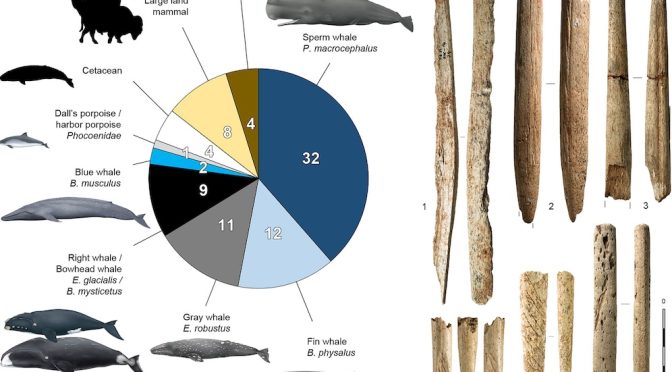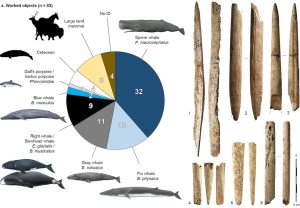Basques have long been associated with whaling. Records as far back as 670 highlight the importance that whale hunting was to the Basque economy and their way of life. However, the people that inhabited the region we now know as the Basque Country used resources from whales even earlier, many millennia earlier. New research has revealed that people on the coast of Bizkaia and the surrounding regions made tools from whale bones some 20,000 years ago.
- A large collection of researchers spanning universities and research centers in Barcelona, Paris, Austria, Santander, Salamanca, Toulouse, Donostia, Switzerland, Oviedo, Denmark, and Canada, amongst others, examined a collection of whale bones found along the Bay of Biscay (Bizkaiko Golkoa in Basque). Using a number of techniques, they dated these bones to 16,000 to 22,000 years ago.
- The most remarkable thing about this find is that some of these bones, a majority even, had been made into tools. That humans made various tools out of whale bone is nothing new, but this is now the oldest evidence of humans doing this, pushing back our understanding of when humans used whale bones in this way by at least 1,000 years.
- Most of these objects are related to weapons, often being projectile points or foreshafts, similar to points made from antlers from a similar time period. Some of them are fragmented, suggesting they were crushed, and leading the researchers to speculate that maybe these bones were brought back to habitats for their fat and oil, which was extracted by crushing the bones.
- In addition, the researchers were able to determine what kinds of whales these were – they use carbon versus nitrogen isotope ratios to identify the different species (you’ll have to dig into the paper for more details). Five different species were identified. Some are expected – sperm, blue, fin whales are still found in the Bay of Biscay today. However, gray and bowhead/right whales are only found in the Arctic, which means that the Bay of Biscay of some 20,000 years ago hosted an even richer biodiversity than it does now. This makes some sense as the waters were colder back then, more akin to today’s Arctic waters. Of course, some of these whales, particularly right whales, were extensively hunted off of the shores of the Basque Country, also contributing to their current absence. However, these whales were likely not hunted, but acquired “opportunistically” as they washed ashore, for example. The humans of the time simply didn’t have the capabilities to actually hunt whales.
- Several of these fragments were found in the modern Basque Country, including in Iruroin, Ermittia, Urtiaga, and Isturitz. However, the generality of these discoveries along the Bay of Biscay suggest that the same types of peoples were responsible for all of these artifacts.
- These types of studies not only shed light on human prehistory, but they provide a broader view of the past world. The researchers were able to also examine the diet of these whales via isotope analysis, finding that their diet and habitat was similar, for the most part, to what whales exhibit today. That said, there are differences that may be partially attributed to changing climate over the last 20+ millennia.
A full list of all of Buber’s Basque Facts of the Week can be found in the Archive.
Primary source: McGrath, K., van der Sluis, L.G., Lefebvre, A. et al. Late Paleolithic whale bone tools reveal human and whale ecology in the Bay of Biscay. Nat Commun 16, 4646 (2025). https://doi.org/10.1038/s41467-025-59486-8
Discover more from Buber's Basque Page
Subscribe to get the latest posts sent to your email.



